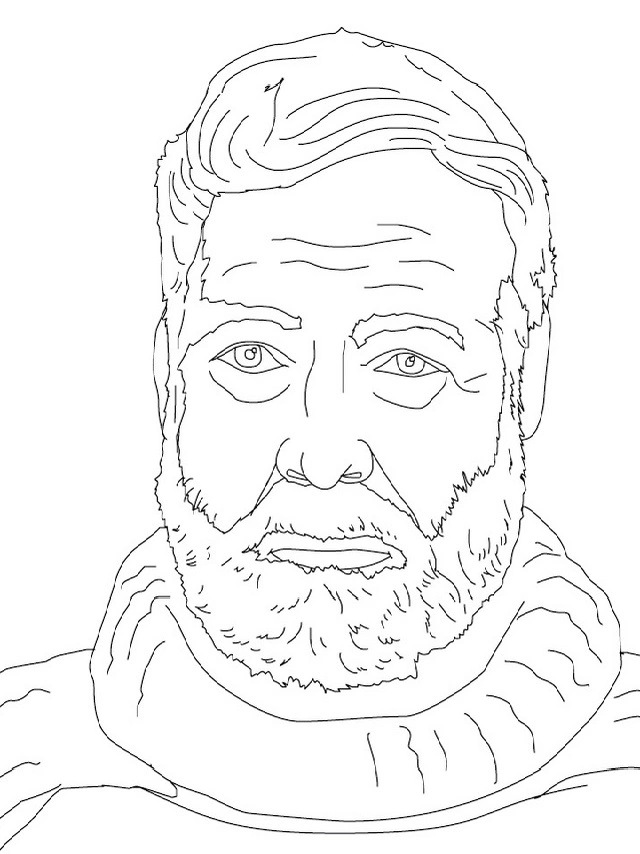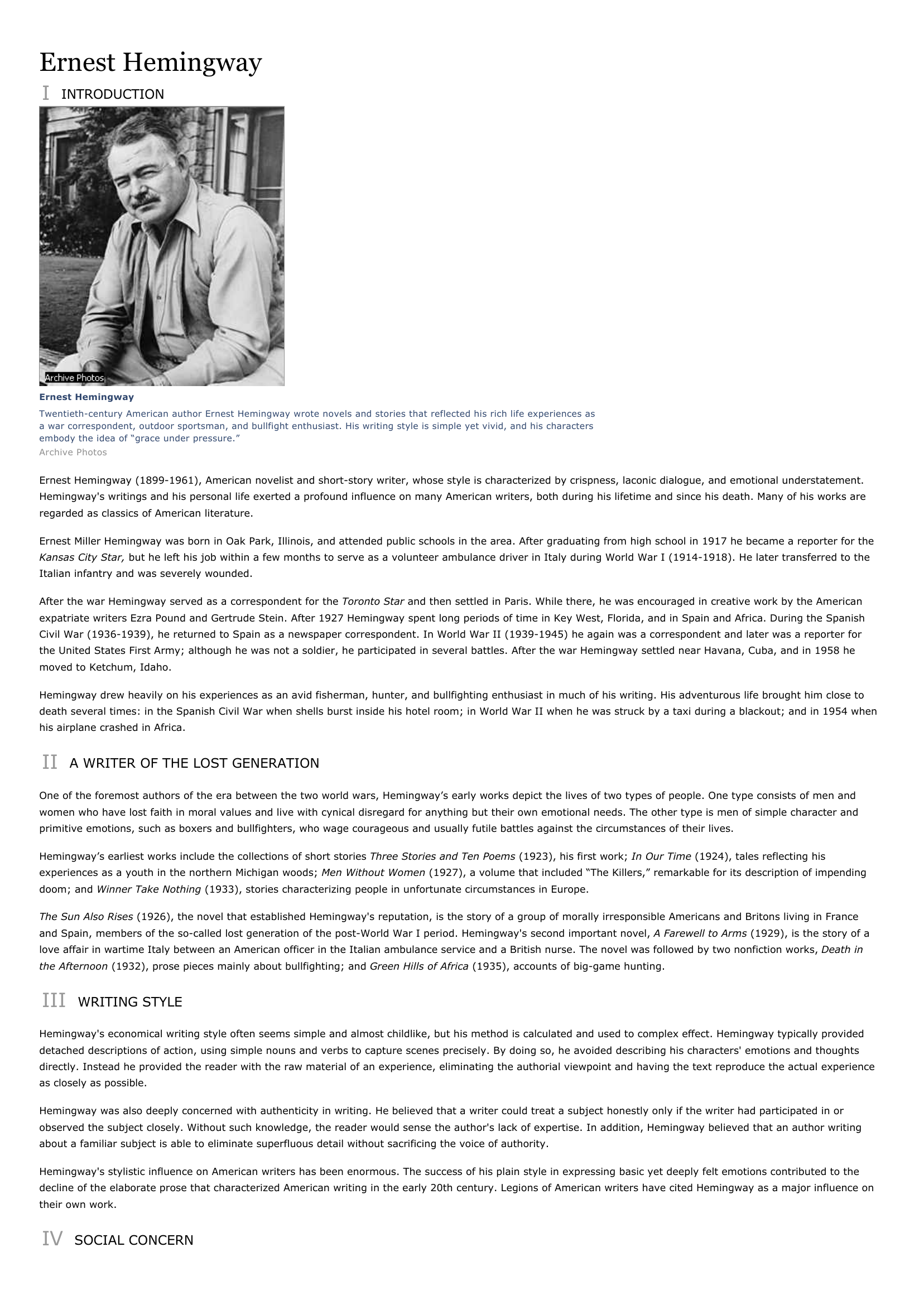Hemingway Ernest Écrivain américain
Publié le 01/04/2019

Extrait du document

Hemingway Ernest Écrivain américain
* 21.7.1899, Oak Park, Illinois + 2.7.1961, Ketchum, Idaho
Il est considéré comme l'écrivain qui a fait renaître la nouvelle américaine au XXe siècle. Ambulancier volontaire pendant la Première Guerre mondiale, Hemingway est blessé sur le front italien. En 1917, il devient journaliste, puis, à partir de 1921, correspondant européen à Paris ainsi que reporter et correspondant étranger au Proche Orient. Il se fait alors connaître par un premier roman, \"Le Soleil se lève aussi\", publié en 1926. En 1937, il est correspondant de guerre pendant la guerre d'Espagne, et assiste ensuite à l'invasion de la France. Cette vie d'aventurier engagé dans les guerres lui inspirent les thèmes et les personnages de ses romans, qu'ils soient torero, chasseur ou pêcheur. Son style expressif et peu sentimental, influencé par le journalisme, correspond d'une manière tout à fait particulière à l'état d'esprit des générations qui, comme lui, ont vécu les deux guerres mondiales. En 1952, il écrit son oeuvre majeure : \"Le Vieil homme et la mer\". Hemingway reçoit le prix Pulitzer en 1953. L'auteur de \"L'Adieu aux armes\" (1929) ; \"Les Neiges du Kilimandjaro\" (1938) ; \"Pour qui sonne le glas\", 1940 ;
\"Paradis perdu\" (1946) ; \"Paris est une fête\" (1960) reçoit le prix Nobel de littérature en 1954. Il se suicide en 1961.

«
Ernest Hemingway
I INTRODUCTION
Ernest HemingwayTwentieth-century American author Ernest Hemingway wrote novels and stories that reflected his rich life experiences asa war correspondent, outdoor sportsman, and bullfight enthusiast.
His writing style is simple yet vivid, and his charactersembody the idea of “grace under pressure.”Archive Photos
Ernest Hemingway (1899-1961), American novelist and short-story writer, whose style is characterized by crispness, laconic dialogue, and emotional understatement. Hemingway's writings and his personal life exerted a profound influence on many American writers, both during his lifetime and since his death.
Many of his works areregarded as classics of American literature.
Ernest Miller Hemingway was born in Oak Park, Illinois, and attended public schools in the area.
After graduating from high school in 1917 he became a reporter for theKansas City Star, but he left his job within a few months to serve as a volunteer ambulance driver in Italy during World War I (1914-1918).
He later transferred to the Italian infantry and was severely wounded.
After the war Hemingway served as a correspondent for the Toronto Star and then settled in Paris.
While there, he was encouraged in creative work by the American expatriate writers Ezra Pound and Gertrude Stein.
After 1927 Hemingway spent long periods of time in Key West, Florida, and in Spain and Africa.
During the SpanishCivil War (1936-1939), he returned to Spain as a newspaper correspondent.
In World War II (1939-1945) he again was a correspondent and later was a reporter forthe United States First Army; although he was not a soldier, he participated in several battles.
After the war Hemingway settled near Havana, Cuba, and in 1958 hemoved to Ketchum, Idaho.
Hemingway drew heavily on his experiences as an avid fisherman, hunter, and bullfighting enthusiast in much of his writing.
His adventurous life brought him close todeath several times: in the Spanish Civil War when shells burst inside his hotel room; in World War II when he was struck by a taxi during a blackout; and in 1954 whenhis airplane crashed in Africa.
II A WRITER OF THE LOST GENERATION
One of the foremost authors of the era between the two world wars, Hemingway’s early works depict the lives of two types of people.
One type consists of men andwomen who have lost faith in moral values and live with cynical disregard for anything but their own emotional needs.
The other type is men of simple character andprimitive emotions, such as boxers and bullfighters, who wage courageous and usually futile battles against the circumstances of their lives.
Hemingway’s earliest works include the collections of short stories Three Stories and Ten Poems (1923), his first work; In Our Time (1924), tales reflecting his experiences as a youth in the northern Michigan woods; Men Without Women (1927), a volume that included “The Killers,” remarkable for its description of impending doom; and Winner Take Nothing (1933), stories characterizing people in unfortunate circumstances in Europe.
The Sun Also Rises (1926), the novel that established Hemingway's reputation, is the story of a group of morally irresponsible Americans and Britons living in France and Spain, members of the so-called lost generation of the post-World War I period.
Hemingway's second important novel, A Farewell to Arms (1929), is the story of a love affair in wartime Italy between an American officer in the Italian ambulance service and a British nurse.
The novel was followed by two nonfiction works, Death in the Afternoon (1932), prose pieces mainly about bullfighting; and Green Hills of Africa (1935), accounts of big-game hunting.
III WRITING STYLE
Hemingway's economical writing style often seems simple and almost childlike, but his method is calculated and used to complex effect.
Hemingway typically provideddetached descriptions of action, using simple nouns and verbs to capture scenes precisely.
By doing so, he avoided describing his characters' emotions and thoughtsdirectly.
Instead he provided the reader with the raw material of an experience, eliminating the authorial viewpoint and having the text reproduce the actual experienceas closely as possible.
Hemingway was also deeply concerned with authenticity in writing.
He believed that a writer could treat a subject honestly only if the writer had participated in orobserved the subject closely.
Without such knowledge, the reader would sense the author's lack of expertise.
In addition, Hemingway believed that an author writingabout a familiar subject is able to eliminate superfluous detail without sacrificing the voice of authority.
Hemingway's stylistic influence on American writers has been enormous.
The success of his plain style in expressing basic yet deeply felt emotions contributed to thedecline of the elaborate prose that characterized American writing in the early 20th century.
Legions of American writers have cited Hemingway as a major influence ontheir own work.
IV SOCIAL CONCERN.
»
↓↓↓ APERÇU DU DOCUMENT ↓↓↓
Liens utiles
- Hemingway Ernest Miller, 1899-1961, né à Oak Park (Illinois), écrivain américain.
- Hemingway, Ernest - écrivain.
- Hemingway Ernest Écrivain
- "Pour qui sonne le glas" Ernest Hemingway
- ASHLEY (Lady Brett). Personnage du roman d’Ernest Hemingway Le soleil se lève aussi

































